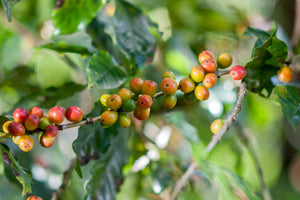Coffee these days is a commodity we're all used to - but if you're looking to get into the origins of our favourite caffeine source or educate yourself about all the complex properties of the coffee plant, there's a lot to learn!
Although we're not 100% sure where coffee came from, legend has it that the first barista was an Ethiopian goat herder called Kaldi.
If you believe the tales, Kaldi decided to take a risk on an odd tree, ate a stack of berries and was wildly wide awake as a result - and the story of coffee began.
Today the Hoxton Coffee team looks into how this (alleged!) punt on a handful of berries grew into a drink that you'll find in every city on the planet and why coffee plants are today produced in over 70 different countries.
How is Coffee Made?
You're probably aware that coffee comes from a plant - these plants can get an incredible ten metres tall in the wild and are evergreens that grow in woodland.
Most coffee is grown in the Bean Belt area, around the hotter equator, across the Middle East, Asia, Africa, Central and South America.
Now, although we call coffee beans, well, beans, that might be a bit confusing!
They're not beans, they're seeds, and they grow inside the cherry on the coffee plant. Each fruit has two seeds, and they have to be picked at just the right time to maximise the flavour.
Each coffee variant and blend has a different harvesting system and matures at specific rates, depending on the time required for the seeds to get to the perfect age.
Once the seeds have been picked from the cherries, they're roasted and turn into the golden brown coffee beans and blends we know.

What Do Coffee Plants Look Like?
If you're trying your hand at cultivating a coffee plant, here's what it should look like:
- Leaves grow in pairs, dark green in colour with a waxy texture (essential for photosynthesis to help the cherries grow).
- Branches start to flower after around three to five years, with tiny, white blooms not dissimilar to jasmine.
- After pollination, you'll see cherries growing in place of the flowers in around six weeks, which turn orange, pink, red or yellow depending on the plant.
Most coffee plants thrive for up to 40 years, although they can get a lot older and look more like a shrub than a tree - excluding those huge species in the wild!
You should prune your coffee plants around once a year to stop them from growing too large, with the ideal height about five to seven feet, so it's easy to keep them in top condition and pick the cherries.
There are thousands of coffee variants because plants grow differently depending on the seed variety, climate, type of soil and altitude they're grown at.
A great harvester picks about 45 to 90 kilos of coffee cherries per day, producing nine to eighteen kilos of coffee beans.
Cherries ripen at different intervals, so the same coffee plant can produce a repeated harvest, although it takes about nine months from flowering until the cherries are ready to pick.
Interesting fact for you!
Bees love coffee plants and are drawn to the nectar on the flowers - it turns out bugs love their morning beans just as much as humans.

What Are the Different Types of Coffee Plants?
Commercial coffee is normally made from one of two plants - Arabica or Robusta.
It doesn't stop there because there are something like 100 Arabica variants, although just a couple of Robusta types.
Arabica Coffee Beans
Arabica coffee is the most common because the coffee is complex, sweet and full of flavour. The first Arabica plants were found in Ethiopia (home of our friend Kaldi).
About 70% of coffee is Arabica, although it's a lot fiddlier to grow, because:
- It's more vulnerable to weather and pests.
- There are fewer cherries per plant to pick.
- Plants grow best in lower temperatures.
Robusta Coffee Beans
Robusta beans are much smaller, with less natural sugar, and have a more bitter and earthy taste with higher caffeine concentrations.
Cherries from Robusta coffee plants are easy to grow, so they're cheaper and used in tons of commercial coffee flavourings and products, including instant.
A Robusta coffee tree is better resistant to infestations, grows well in warmer climates, and provides more cherries per plant.

The Anatomy of a Coffee Bean
As we've explained, each coffee cherry has two seeds, covered by layers that growers need to take off before they can start roasting.
Coffee beans are tiny, detailed little globes of flavour and nutrients, and they have lots of different coatings:
- The exocarp is the outer peel, which starts out green and changes colour as the fruit ages.
- A mesocarp sits underneath the peel, a thin layer of pulp.
- You get the endocarp underneath that, which is like a papery layer covering the coffee bean, hardening to stop the bean from getting too large.
- Before you get to your coffee, you need to get past the spermoderm, another thin membrane or skin that sits on the seed.
- Finally, we uncover the endosperm, the bean that is a gorgeous green, before it's roasted.
Coffee connoisseurs will know how intricate each bean is and how much work goes into growing, cultivating and harvesting these seeds, stripping away the layers before getting anywhere close to the ground coffee in our mugs.
How Long Do Coffee Plants Live?
Commercially farmed coffee plants don't live quite as long as their wild cousins - normally about 20 to 30 years on average.
If a seed is planted, instead of roasted, it will grow shoots and vibrant leaves, usually kept in a nursery until the plant is old enough to be moved outdoors.
Coffee plants don't start producing flowers and cherries for the first few years, but they'll bloom after heavy rain when they mature, which then creates those precious cherries.
Colombia, one of the worldwide coffee-growing hubs, usually has two periods of heavy rain and, therefore, two harvests every year.
The trick to a perfect roast is knowing precisely when to harvest, which could be anything from four to nine months.
It's well worth taking the opportunity to visit a coffee farm or see some of these amazing trees in the wild, whether a delicate young plant just beginning to bud or an ageing coffee tree giant that has provided more cups of coffee than we could ever count.
Picking a Perfect Coffee Variant
When you next brew a pot or buy a coffee, have a look at the label to see which variant you're drinking and where those beans have been harvested - the more you know, the more fascinating it gets!
Our coffee roasters specialise in selecting small-batch coffees and developing unique blends that deliver a remarkable taste sensation.
Both our Proper Strong and East End Blend are carbon negative and closed-loop, selected for flavour, quality, strength, and signature profiles that make them the best beans for the job.
If you're curious to find out more about Hoxton Coffee, Eco Roast or how we arrive at our careful barista bean selections, please take a look at our Coffee Blog.

